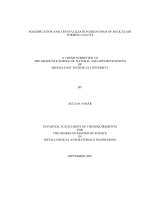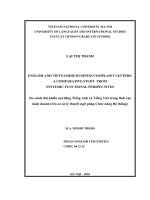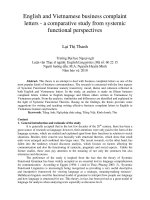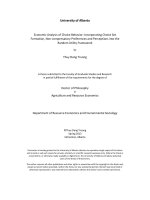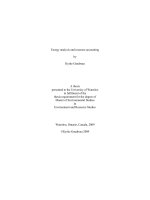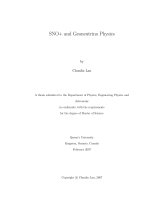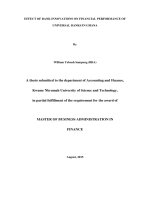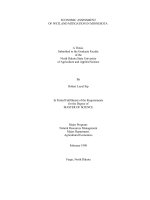ENGLISH AND VIETNAMESE JOKES from a pragmatic perspective
Bạn đang xem bản rút gọn của tài liệu. Xem và tải ngay bản đầy đủ của tài liệu tại đây (886.02 KB, 47 trang )
ENGLISH AND VIETNAMESE JOKES:
FROM A PRAGMATIC PERSPECTIVE
(Phân tích truyện cười Anh- Việt trên bình diện ngữ dụng học)
M.A. Minor Programme Thesis
Field: English Linguistics
Code: 60 22 15
Course: 17
1
ABSTRACT
This thesis intends to interpret English and Vietnamese jokes from a pragmatic perspective
and explores about the way language used for humor to raise the awareness of pragmatics
for the interpreter.
To accomplish this research, the theoretical preliminaries of pragmatics and humor are
worked out for the interpretations. The five English jokes and five Vietnamese jokes are
taken from the reliable sources according to certain criteria concerning the structure of
jokes, joke context and a variety of situations.
The findings from the analysis have revealed that we can analyze the set- up of each joke
based on the speech acts of Austin and Searle and find humor through the punch line due
to violating and flouting the conversational maxims of Grice. What's more, the study
provides the interpreter the better understanding of pragmatics and useful pedagogical
implications.
Hopefully, this will be a valuable material for those who are interested in the aspects of
pragmatics.
2
ABBREVIATIONS
CP : The Cooperative Principle
QUAL. : Quality
QUAN. : Quantity
QDA. : Qualitative data analysis
REL. : Relevance
MAN. : Manner
EFL : English as a Foreign Language
E. joke : English joke
V. joke : Vietnamese joke
PART A: INTRODUCTION
1. Rationale of the study
One of the best ways to understand people is to know what makes them laugh.
(H. Golden)
3
It is worth saying that we can laugh when reading or hearing jokes if we can understand
what make us laugh. Hence, we should know the communication between the participants
in jokes, the context jokes take place, and the language used. Pragmatics, therefore, will let
us know what make us laugh and then we may say jokes are interesting for our life.
And we now also understand that we should pay more attention to the study of jokes
pragmatically as semantic analysis, sociological analysis, etc. on jokes have been studied
quite extensively over the years. Pragmatic analysis is, thus, a relatively new approach of
language. And quite different from other linguistic studies, pragmatics puts more attention
on language users and the context in which the language is used. And in fact, in analyzing
jokes pragmatically, we might find a harmony between language for humor, language users
and contexts.
It is so much hoped that the study may bring a good understanding of pragmatics and
concepts of pragmatics via English and Vietnamese jokes. When analyzing jokes, the
author is trying to reveal how the matters are interpreted in the jokes. Another reason is
that, as a teacher of English, the author wants to help Ha Tinh university learners of
English not only read a regular text but understand its functions in context. The study is
also hoped to offer a suggestion about the pragmatic reading of any jokes, which, in turn,
help shaping a scientific view towards pragmatics. Lastly, the author wants to share a
significant reference of jokes for others who are willing to make another further pragmatic
research.
2. Aims of the study
The aims of this study are:
• To provide whether the theory of speech acts and theory of conversational maxims
has explanatory power on humor in English and Vietnamese jokes.
• To figure out a brief account of possible similarities and differences between
English and Vietnamese jokes in terms of the speech acts and conversational
maxims.
• To provide some proposals for further study and pedagogical implications for
raising Ha Tinh university students’ pragmatic awareness.
3. Scope of the study
4
Many fields of pragmatics related to jokes need to be explored and a variety of jokes can
be selected. However, due to the limited time, the study is confined to the following
aspects:
• Only five English jokes and five Vietnamese jokes are selected to test the
theoretical preliminaries, and the jokes chosen must have the set- up and the punch
line (two way- communication).
• Speech acts of Austin including locutionary, illocutionary and perlocutionary act
are explored to interpret the set- up of English and Vietnamese jokes.
• Types of Searle’s illocutionary act including directives, commissives, expressives,
representatives and declaratives are used to identify speech acts.
• Non- observance of conversational maxims looked at only due to flouting and
violating.
• The inferences made in context to interpret the way of conducting conversational
maxims of joke participants.
• This is a linguistic study for academic purpose only.
4. Methodology of the study
The methodology employed is a qualitative research. This is a study of grounded theory. It
has been acknowledged that with this method, the researcher as an instrument for gathering
data during the study. The data is analyzed inductively, selected in the form of words, and
done before finding out the research questions.
The process for the qualitative data analysis (QDA), Corbin and Strauss (1990: 62)
will be:
• Noticing: This step means gathering English and Vietnamese jokes and the
theoretical preliminaries related to the topic. This is done by producing a record of
interesting things and coding them. Then, a descriptive scheme is developed for the
study.
• Collecting: The second step means sorting the date into discrete parts under the
analysis. The statistics are done to adopt percentages and scales based on the
analysis results for each part to determine significance of data.
5
• Thinking: In this step, English and Vietnamese jokes are firstly examined closely
with the theoretical background. Secondly, the constant comparisons are intended
to identify similarities and differences between English and Vietnamese jokes.
Moreover, questions are always asked about the phenomena as reflected in the data
to generalize findings for the study and provide pedagogical implications.
The joke collection:
• Five sample English jokes are selected from an English linguistic book and two
reliable websites: . Reader’s Digest, .
• Five sample Vietnamese jokes are selected Vietnamese funny story books and two
reliable websites: , /> The research questions:
• How are English and Vietnamese jokes analyzed pragmatically?
• What are the similarities and differences between English and Vietnamese jokes
as seen from a pragmatic perspective?
• What tips are utilized to improve the awareness of pragmatics of learners via the
study?
The hypotheses of the study are formulated
• All the types of speech acts proposed by Austin (1955) and Searle (1969) are
found in English and Vietnamese jokes.
• Conversational maxims are broken to arouse humor.
• Different breakings of maxims result in different ways of producing humor in
English and Vietnamese jokes.
5. Format of the study
The study begins with declaration, acknowledgement, table of contents, and abbreviation.
The main body of the study consists of three parts. They are introduction, development and
conclusion.
Part one provides a brief account of relevant information about the rationale, aims, scope,
methodology and format of the study.
6
Part two includes three chapters
• Chapter 1: This chapter is about theoretical notions necessary for the study
including the theory of pragmatics, concepts of pragmatics, and theory of jokes.
• Chapter 2: This chapter offers an analysis of English and Vietnamese jokes one by
one. Firstly, the speech acts and conversational maxims are applied to interpret the
set- up and the punch lines of the jokes. Secondly, the similarities and differences
between English and Vietnamese jokes will be worked out in terms of speech acts
and conversational maxims.
• Chapter 3: This chapter is about some implication of the study for EFL teaching
and learning.
Part three includes concluding remarks, limitation of the study, and recommendations for
further research.
Apart from the three main parts, the references and the appendix of the study are included.
PART B: DEVELOPMENT
CHAPTER 1: THEORETICAl BACKGROUND
This chapter will discuss several joke and pragmatic issues which serve as theoretical
foundation for the study. First a brief review on theory of jokes such as definitions of
jokes and incongruity theory. Then theories of pragmatics related to jokes, mainly
definitions of pragmatics, speech act theory, conversational implicature and context,
cooperative principle, conversational maxims and principles of conducting maxims are
presented.
7
1.1. Theory of jokes
1.1.2. Definition of jokes
According to Collins Cobuild English Dictionary (1987: 256), jokes are “something that is
said or done to make people laugh, i.e. a funny story.”
Suls (1972) cited in Antony (1976: 37) proposed a model for the appreciation of jokes.
This involves a two stage- process which relies on the generation and disconfirmation of
a listener’s expectations. Raskin (1985) cited in Gruyter (2001: 195) proposed a similar
theory of humor, a joke begins by being compatible with one script, and then a script-
switch trigger occurs which is inconsistent with the original script. The trigger is usually
the punch line. The listener then searches for an alternative, more compatible script. The
humor lies in the overlap between the two scripts. Raskin (1994:100) uses the following
joke to illustrate his point:
• "Is the doctor at home?" The patient asked in his bronchial whisper.
"No," the doctor's young and pretty wife whispered in reply. "Come right in."
According to Raskin, the joke body activates the doctor- patient script, but the punch line
forces the cognitive agent to backtrack and reinterpret the joke in a lover script.
Hockett (1972: 84) states that a joke consists of a build-up and a punch. Similarly, Sherzer
(1985: 216) defines a joke as “a discourse unit consisting of two parts, the set- up and the
punch line”. The set-up (the initial portion) is normally built of a joke, while the punch line
(the second part) is the final portion of the joke, which leads to incongruity with the set-up
to provoke laughter and demands creating thinking to surprise the readers. The punch line
is the funny part of the joke. It can change the situation of the joke in order to make people
laugh. It is the climax of the joke in which the amusing part takes place. Therefore, any
type of the jokes should have the punch line so readers may laugh. In order to make the
incongruous clearer, the following attentions will be given to the incongruity theory.
1.1.3. Incongruity theory
This theory means that humor will happen when there are two things which are in
conflict. People will laugh if they can see those contradictions. Sultz (1976) cited in
Richie (2004: 48) refers to incongruity as "a conflict between what is expected and what
actually occurs in the joke”. This belief is supported by Schopenhauer (1883) cited in
8
Ritchie (2004: 46), "The cause of laughter in every case is simply the sudden perception
of the incongruity between a concept and the real objects which have been thought
through it in some relation, and laughter itself is just the expression of this incongruity.”
However, some linguists disagree with the given definitions, they see the incongruous
part cannot make the perceiver laugh, but have to solve the contrary part. The adding
stage is called "a two stage- model", incongruity- resolusion. According to this model, the
cause of incongruity of joke is the pragmatic is broken and it makes readers astound. The
way of creating and resolving the incongruity can be analyzed as follows:
• "Is the doctor at home?" The patient asked in his bronchial whisper.
"No," the doctor's young and pretty wife whispered in reply. "Come right in."
The example says that the answer is seen as incongruous, with "No” ”Come right in"
interpreted as an absence of the doctor and an invitation of the patient to enter in the
house, but then the resolusion occurs with the realization that there is another
interpretation, "the wife wants to have a secret meeting with the patient” basing on the
gender of the doctor’s wife, her description as well as the absence of the doctor or her
husband.
1.2. Theories of pragmatics related to jokes
1.2.1. Definitions of pragmatics
J.L. Austin, a philosopher at Oxford University (1940s-1950s) who was interested in
language, laid the groundwork for what was to become pragmatics. Austin wanted to know
how humans manage to communicate despite the imperfections in language. One important
reason for why Austin was interested in language was that he was convinced that we do not
use language to say things (to make statements), but to do things (perform actions),
Thomas (1995: 31).
According to Levinson (1983: 12), “Pragmatics is the study of all those aspects of
meaning not captured in a semantic theory.” This means that it has consequently more to
do with the analysis of what people mean by their utterances than what the words or
phrases in the utterances might mean by themselves. What is learnt from Crystal (1985:
225), “Pragmatics is often contrasted with semantics”, which deals with meaning without
reference to the users and communicative functions of sentences. On the contrary,
9
pragmatics includes the study of how the interpretation and use of utterances depends on
knowledge of the real world, how speakers use and understand the speech acts, and how
the structure of sentence is influenced by the relationship between the speaker and the
hearer. Furthermore, it is significant for participants to share knowledge together so that
the hearer may minimize to misinterpret the speaker’s intended meaning.
Pragmatics is the branch of linguistics concerned with how humans use language, what the
speaker means and how the hearer interprets the words uttered. A sentence uttered by a
speaker can be separated into two levels of meaning: firstly the literal-propositional, i.e. the
expressed meaning, which remains the same no matter what the context is and secondly the
implied meaning, which is what the speaker means on a specific occasion, Thomas (1995:
2-8). The expressed meaning is the meaning that we understand by interpreting the word or
phrase based only on the information we get from the words uttered. Considering an
example, “Are you thirsty?”
The sentence like this is easy to interpret where the obvious meaning is a request for
information about the hearer, i.e. if he is thirsty. However, the same sentence can have a
different meaning besides the literal-propositional. That meaning will be dependent on the
context in which the sentence is uttered. Suppose that the speaker and the hearer are lost in
the desert and have had nothing to drink for days; such an utterance might then be uttered
as a joke, the hearer is obviously thirsty, in order to embolden in a time of struggle. In
another context it could mean that the speaker wants the hearer to get him a drink. This is
considered to be an example of speech acts, where the speaker intends the hearer to carry
out an action.
Although there is no single, generally- accepted definitions of pragmatics and what it
encompasses, since the field is broad and diverse, the above definitions of pragmatics sum
up on the area that we have focused on analyzing jokes. However, in order to interpret the
speaker’s intended meaning in producing jokes, the following concepts of pragmatics
should be mentioned.
1.2.2. Speech act theory
Speech act theory is not the whole of pragmatics, but is perhaps currently the most
important established part of the subject. According to this theory, when uttering
something, people are not only saying something but doing something. Austin further
10
concludes that "issuing an utterance" a speaker can perform three acts simultaneously:
the locutional, the illocutional and the perlocutional acts, Austin (1955: 5).
1.2.2.1. Locutional act
This is the basic act of utterance, or producing a meaningful linguistic expression. Let’s
take an example of “The bar will be closed in five minutes.” The bartender is thereby
performing the locutionary act of saying that the bar (the one he is tending) will be closed
in five minutes (from the time of utterance).
1.2.2.2. Illocutional act
Mostly we don’t just produce well- formed utterances with no purpose. We form an
utterance with some kind of function in mind. This is the illocutionary act. The
illocutionary act is performed via the communicative force of an utterance. We might
utter the sentence above to make a statement, an offer, an explanation, or for some other
communicative purpose. This is also generally known as the illocutionary force of the
utterance. For instance, in saying that, "The bar will be closed in five minutes.” The
bartender is performing the illocutionary act of informing the patrons of the bar's
imminent closing and perhaps also the act of urging them to order a last drink. Thus, it is
necessary to know this act because if we do not understand why a language is being used
as it is, we cannot understand its meaning in the context of social interaction, Saville
(1989: 15-16).
1.2.2.3. Perlocutional act
We do not, of course, simply create an utterance with a function without intending it to
have an effect. This is the perlocutionary act. Depending on the circumstances, we will
utter that sentence on the assumption that the hearer will recognize the effect we
intended. This is also generally known as the perlocutionary effect. Suppose, for
example, that a bartender utters the words, "The bar will be closed in five minutes.” He
intends to be performing the perlocutionary acts of causing the patrons to believe that the
bar is about to close and of getting them to order one last drink, Yule (1996: 48).
Of all the three acts, the most discussed is the illocutionary act, or also what counts as the
intended meaning of the utterance. Besides, to give a clear difference between
11
illocutionary verbs and acts, Searle (1969: 60) identified the various types of conditions
underlying speech acts. He divides speech acts into five classes.
• Representatives: acts that commit the speaker to the truth of the expressed
proposition, using such verbs as affirm, believe, conclude, deny, report, etc.
• Directives: acts that ask the speaker to get the other to do something with verbs
such as request, question, etc.
• Declaratives: acts that affect immediate changes in the institutional state of
affairs and tend to rely on elaborate extra-linguistic institutions, with verbs such
as appoint, declare, etc.
• Commissives: here the speaker commits himself (or herself) to a (future) course
of action, with verbs such as: guarantee, pledge, promise, swear, vow,
undertake, warrant.
• Expressives: the speaker expresses an attitude to or about a state of affairs,
using such verbs as: apologize, appreciate, congratulate, deplore, regret, etc.
Overall, the theory of speech acts is applied in order to see whether what the speaker
intends to convey with such an utterance and what the hearer has inferred from that
utterance. The hearer, therefore, could be guided to use a particular world knowledge fit to
the context. This knowledge helps him understand what happens in the text is related to
how he may understand what has happened in the world as well. In understanding a text,
he retrieves the world knowledge, which is already stored in his memory, and then relates
it to the discourse. For example, he reads a story about a visit to the relatives; he uses his
knowledge of visiting those people instead of that of sending an email or going to a picnic.
Thus, he only uses a limited subset of the knowledge required to understand such a
discourse. The limited subset is called schemata, which leads him to expect what aspects in
his interpretation of discourse.
1.2.3. Conversational implicature and context
One of the most important concepts in pragmatics is ‘conversational implicature’. It is
meant to provide an account of how it is possible to mean more than is actually said.
Conversational implicature is generated directly by the speaker depending on the context.
This implicature may or may not be understood, Thomas (1995: 58). The same expressed
meaning can have different implications on different occasions.
12
Another concept that related to the conversational implicature is context. The context
defined in Oxford Advanced Learner’s Dictionary of Current English, p.282 is “words
that come before and after a word, phrase, statement, etc., helping to show what its
meaning is” or “circumstances in which something happens or in which something is to
be considered”. Now, we can say, on the one hand, to judge whether an implicature is
made or not, or what it may implicate, one needs to review what has been said and
preview what will be said later on, or figure out what is going on around. And on the
other hand, to implicate something, one may try to invoke the CP by a word, phrase or
statement that feels like superfluous, false, irrelevant or fuzzy. To illustrate those two
concepts, we have taken these examples from Cruse (2000: 349):
• A: Have you cleared the table and washed the dishes?
B: I’ve cleared the table.
• A: Am I in time for supper?
B: I’ve cleared the table
In the first example speaker B’s implication is that he has cleared the table but has not
washed the dishes, while in the second example speaker B’s implication is that speaker A
is late for dinner. Thus, A is able to infer the message in B’s utterance, by appealing to
the rules governing successful conversational interaction. What is said and what is
implicated, therefore, together form the meaning of the utterance in a given context. The
context is constituted by the knowledge shared between the speaker and the hearer. The
shared knowledge of two types: the knowledge of the language they use, and the
knowledge about the world, including the general knowledge about the world and the
specific knowledge about the situation in which linguistic communication is taking place.
1.2.4. The cooperative principle
In order to explain how hearers interpret the utterance implicature, Grice introduced the
Cooperative Principle (CP). The CP runs like this: “Make your contribution such as is
required, at the stage at which it occurs, by the accepted purpose or directions of the talk
exchange in which you are engaged,” Grice (1991: 26). According to the CP both
speaker and hearer converse with the willingness to deliver and interpret a message. The
speaker and hearer cooperate and that is why they communicate efficiently, Thomas
(1995: 63).
13
1.2.5. Conversational maxims
In order to illustrate how we interpret meaning, Grice presented, in addition to the
Cooperative Principle, four conversational maxims to show how we communicate
effectively in the light of certain rules. Thanks to Grice’s maxims, we can interpret and
understand the underlying implication of an utterance, Thomas (1995: 63). The maxims
of conversation which together express a general cooperative principle are:
1.2.5.1. The maxim of quantity
The maxim requires the speaker to give the right amount of information when s/he
speaks, which means not to be too brief or to give more information than the situation
requires, Thomas (1995: 63). For example, the speaker fails to observe the maxim when
he says “I’m feeling good today, but yesterday I was very ill, and the day before that,
even worse.” In this context the utterance contains too much information and the maxim
is not being observed.
1.2.5.2. The maxim of quality
The maxim is a matter of giving the right information. The speaker says nothing that s/he
believes to be false or for which s/he lacks sufficient evidence, Thomas (1995: 67). The
other maxims are dependent on this maxim. This is because, if a speaker does not convey
the truth then the utterance is false, even if the right amount of information is given or the
speaker is clear and orderly when speaking, Finegan (1994: 341). An example of non-
observance is: “You look good with your new haircut” when one actually believes the
opposite. The statement is then an untruth, the speaker fails to observe the maxim in
order to be polite.
1.2.5.3. The maxim of relevance
This maxim requires the speaker to be relevant to the context and situation in which the
utterance occurs, Thomas (1995: 70). For instance, the speaker should not say “I am on
the phone” when someone asks if she wants dinner. Here, the utterance meaning is
irrelevant and the speaker fails to observe the maxim.
1.2.5.4. The maxim of manner
This maxim is a matter of being clear and orderly when conversing. The speaker
describes things in the order in which they occurred and avoids ambiguity and obscurity,
14
Thomas (1995: 64). A speaker fails to observe the maxim of manner when he says “I
went to bed and got undressed” when, of course, he undressed first and then went to bed.
The above maxims are not supposed to describe how people actually said they merely
attempt to describe a type of conversational practice that is reasonable to follow. When
people, for instance, aim to tell a joke or story, Grice (1991: 29).
1.2.6. Principles of conducting maxims
The maxims can be conducted by doing an observance of the maxims or a non-
observance of the maxims of Grice (1975) cited in Thomas (1995: 61- 62). If the speaker
observes all maxims, there is no distinction between what the speaker says and what he or
she means so there is no implicature could be.
To serve for the interpretation of jokes, we will go into a non-observance of the maxims.
Any failing to observe a maxim may be referred to as ‘breaking a maxim’. When the
speaker breaks a maxim, the hearer looks for the implicature since he assumes the CP to
be in operation. Non-observance of maxims is often used intentionally in order to evoke
humor or to avoid discomfort. Grice discussed five ways of not observing a maxim. They
are flouting, violating, opting out, infringing and suspending. However, we only discuss
non- observance due to flouting and violating in this study.
1.2.6.1. Flouting
There are two reasons why the speaker flouts a maxim. One is a clash between maxims
and another is flouting one of the maxims. With a clash between maxims, it is common
for a speaker to flout between maxim of quality and quantity or quantity and manner. For
example, A is driving B to John’s house. A: Where does John live? - B: Neveda. There is
a clash between the maxim of quantity and quality because A is looking for a street
address, but B gives less informative statement, thus the maxim of quantity is flouted. If
B does not know anything more specific, however, he cannot give a more informative
statement without flouting the maxim of quality. When flouting a maxim, the speaker
does not intend to mislead the hearer but wants the hearer to look for the conversational
implicature, that is, the meaning of the utterance not directly stated in the words uttered.
Therefore, when the speaker intentionally fails to observe a maxim his purpose may be to
effectively communicate a message, Thomas (1995: 65). Accordingly, if working under
15
the cooperative principle the hearer will interpret the message and fill in the missing
information relying on the context. To illustrate,
• A: Has John got a girlfriend?
B: He’s been making a lot of trips to Paphos lately.
The maxim of quality is flouted so that the speaker derives the implicature that John may
have a girlfriend in Paphos.
• A: Where’s Meredith? - B: The control room or the science lab.
The quantity maxim is flouted because B does not give as much information as A wants
(Meredith’s exact location), but instead gives a weaker statement (giving two possible
options). This implicates that B does not know which of the two places Meredith is.
• A: You really love me?
B: I like college football and things that go real fast.
The maxim of relevance is flouted as B is changing the topic. This can be inferred that B
doesn’t want to respond to A.
• A: When are you coming home?
B: I will codify that question to my superiors and respond at such a time as
an adequate answer is preparable.
The maxim of manner is flouted as B is using unnecessarily complicated and confusing
words and construction. We can derive the implication that B does not know or does not
wish to give an answer to the question.
1.2.6.2. Violating
In contrast to flouting, when violating a maxim the speaker intends to mislead the hearer.
The speaker speaks the truth but implies what is false, Thomas (1995: 72). Violating is
found in the examples of jokes extracted from Attardo (1994: 272) as follows:
• A: Excuse me, do you know what time it is? - B: Yes.
It can be seen that the answer in this example violates the maxim of quantity because it
does not provide enough information for the speaker.
• A: Why did the Vice President fly to Panama?
B: Because the fighting was over.
16
The example deliberately violates the maxim of quality by insinuating that the Vice
President is a coward.
• A: Do you believe in clubs for young people? - B: Only when kindness fails.
Violating the maxim of manner is found since the ambiguity of word happens in the joke
(the double meaning of the word clubs).
• A: How many surrealists does it take to screw in a light bulb? - B: Fish!
In this example, the maxim of relevance is violated because the word “surrealists” is
associated with a completely bizarre answer “fish”.
Summary
We have briefly reviewed theory of jokes and pragmatic theories related to jokes. They are
Grice’s Cooperative Principle, Austin and Searle’s Speech Act Theory. On the basis of the
pragmatic theories, we have carried out sample analyses of jokes. At the same time, humor
can be caused in the context. In short, this chapter has been the theoretical background for
the study.
CHAPTER 2: ANALYSIS AND FINDINGS
This chapter is aimed at discovering how English and Vietnamese jokes are analyzed
pragmatically and what similarities and differences between English and Vietnamese
jokes as seen from a pragmatic perspective. First, analyzing jokes one by one basing on
speech act theories and conversational maxim violations, then this analysis presents the
results and findings. Besides, analysis dificulties and discussions will be given to provide
an overall picture of the issue under study.
2.1. Difficulties of joke analysis
2.1.1. Cultural factor
In order to understand humorous language, we cannot ignore the cultural background.
Culture is marked by its abstractness and complicatedness; yet, the mirrors in which
culture finds its reflections present concrete pictures: human behavior, etc. Language, one
of the important such mirrors, represents just as much culture as any other forms. Many
jokes give us a list of aspects such as social and cultural facts that frequently cause humor.
Thus, in order to make an effective comparison and analysis, the interpreter must take the
17
cultural factor into consideration. This requires the competence of cultural recognition and
transmission.
2.1.2. Making inferences
Inference is crucial to interpretation because a good deal of meaning is implied rather
than being explicitly stated. Inferences can be made from what is said and all the
available facts about the world known to joke participants. However, the inference might
be wrong, because this depends on the degree of knowledge of the interpreter. The
interpreter must make inferences that could be justified. If the inferences are wrong, other
inferences must be recreated to replace. Overall, the inference is a complicated process
for the analysis.
2.2. Analysis procedures
In order to answer the three given research questions, English and Vietnamese jokes will
be analyzed one by one. The analysis is organized into two main steps.
• For the step one: we analyze the set- up of English and Vietnamese jokes one by
one basing on the speech acts of Austin and Searle, and determine the punch lines.
• For the step two: we analyze how the participants of the jokes to break maxims to
derive the implicature. We look at which of the four- quality, quantity, relevance
and manner broken in each joke. Furthermore, we look at the reason to why the
maxim is broken and distinguish between flouting and violating a maxim. Besides,
the inferences were made to understand the punch lines of the jokes.
Then the analysis results are summarized in the form of tables and findings are performed
from the analysis.
In order to mark the jokes, they are given numerical symbol, from 1-5 for English jokes
and 6 to 10 for Vietnamese jokes. They are organized in two parts- part 2.3.1 for the first
step and 2.3.2 for the second step. The order of the jokes in each part does not serve any
special purposes.
2.3. Joke analysis
2.3.1. Speech act analysis of the set- up in English and Vietnamese jokes
(E. joke 1) In this joke, when a customer was enjoying his meal, he suddenly cried,
18
“Waiter! There is a ”
The locutionary act of this utterance is stating that there was a fly in his soup. At that time,
the illocutionary act he carried is complaining the meal service. The perlocutionary act is
that the waiter would give him another extra soup. To be more precise, we can see this as
the act of representative as this customer has reported this news to the waiter. Furthermore,
the punch line arouses when the waiter responded “ everyone will want a fly”. Thus, the
waiter in this joke overturns the common cultural practice and the target cultural role in
giving an incongruous reply to the customer.
(E. joke 2) Uttering that,
“were you born in a barn?”
The mother is performing the locutionary act of asking her son whether he was born in a
barn, the illocutionary act of insulting her son as a horse when he forgets to close the door
and the perlocutionary acts of getting her son to close the door. As defined by Searle, this
act is considered as a directive because the mother requests her son to close the door when
he goes out and in. Whereas, the son does not take the message literally so the humorous
part takes place, “I was born in a hospital with automatic doors.” However, he successfully
communicates his message in a very appealing way, making better effect on his mother
about refusing to close the door.
(E. joke 3) In this joke, when the woman sees how romantic the neighbor towards his
wife, she said to her husband,
“Dear, look at the new spouse there. Every time before going to work, the husband always
kisses his wife forehead first Why don’t you do so?”
Thus, the locutionary act of this utterance is telling about their neighbor’s behavior towards
his wife and asking why her husband does not do so. She is actually performing the
illocutionary act of requesting her husband to kiss her before going to work as the neighbor
had done to his wife. This is also the act of directive. Meanwhile, the perlocutionary act is
that her husband would kiss her before going to work. In contrast, the husband arouses the
punch line of this humor when he said, “How can I dare? If I do so, her husband will
surely get mad.”
19
(E. joke 4) When the man asks the woman, “Does your dog bite?” the locutionary act of
the utterance is asking for whether the dog would bite, the illocutionary act is the same. It
can be seen that this is an act of directive. The perlocutionary act is that the dog would
not bite him. However, the dog does attack him and the punch line comes when the
woman said, “ but that’s not my dog”
(E. joke 5) After hearing about the good news, Smith said, the locutionary act of this
utterance is questioning about what the good news is and the illocutionary act of this
utterance is questioning about what the good news is, too. The patient manages to get the
doctor to tell him something that is really good news so this is also called a directive act.
Therefore, the perlocutionary act he intended is that the doctor would tell something that
was really good news. However, instead of telling good news, the doctor said, “Actually,
your leg is no need to be amputated.” It is the punch line of the joke.
(V. joke 6) In this joke, when the beggar raised his hat and said,
“Thưa bà, nhà cháu mất một chân”.
He is performing the locutionary act of informing the reason why he asks for donations.
And the illocutionary act is the same. We can call this as a representative act because the
beggar is reporting his problem. Then, the perlocutionary act he expects that the rich
woman would give him something. However, she ignores his request and responds, “Có
thể lắm, nhưng tại sao anh lại tưởng chân anh mất ở đây?” This utterance becomes the
punch line of this joke.
(V. joke 7) After blaming for the people’s ill- treatment, the mandarin’s wife is consoled
by hearing that they are waiting for him with presents before seeing him off. Furthermore,
she asks the servants,
“họ lễ gì thế các thầy?”
By doing so, the locutionary act of her utterance is demanding the servants about presents
from those residents. The illocutionary act she carried is questioning about the presents.
This is also the act of directive. The perlocutionary act is that the people should give him
presents. The punch line arouses when the servant responded: “Bẩm toàn gạo, muối ”
(V. joke 8) Saying that,
“Mày ăn nói chẳng có đầu đuôi gì cả, người ta cười cả tao lẫn mày.
20
Từ nay nói cái gì thì phải nói cho có đầu có đuôi nghe không?”
The locutionary act is stating that the servant is careless about his saying and that he has to
be more careful from now on. The illocutionary act of the utterance is commanding his
servant to behave well. In fact, this is also called a directive act. Thereupon, the
perlocutionary act of that utterance: he intends that the servant would obey his order.
However, the punch line arouses as the servant details his utterance, “Thưa ông, con tằm
nó nhả ra tơ, và áo ông đang cháy.”
(V. joke 9) While a man asked about his lost pig,
“Bác có thấy con “lợn cưới” của tôi chạy qua đây không?”
The locutionary act of the utterance is asking if this man sees a pig. At that time, the
illocutionary act of the utterance is asking if this man see a pig. This is a directive act but
with the aim of informing that the lost pig is a wedding pig. The perlocutionary act is to
boast a big wedding with a pig. The punch line arouses when the man in a newly- cut robe
responses, “Từ lúc tôi mặc cái "áo mới" này, tôi chẳng thấy con lợn nào chạy qua đây
cả!”
(V. joke 10) When listening to her husband’s last request,
“Bây giờ anh đang gần đất xa trời rồi, em có thể thú nhận về mối quan
hệ của mình với tay hàng xóm được không?”
The spouse is wondering whether his wife would tell him her adulterous relationship with a
neighbor (the locutionary act). The illocutionary act is that he requests his wife to tell him
the truth. We can say this illocutionary act is a directive act. The perlocutionary act of this
utterance is that her husband forces her to tell the truth so that he could die without any
trouble in mind. The punch line comes when the wife said, “Thế nhỡ anh không chết thì
sao?”
2.3.2. Maxim analysis of the punch line in English and Vietnamese jokes.
Analyzing the punch lines due to maxim non-observances we looked at were flouting and
violating. We observe breakings of maxims in five English jokes and the same amount for
Vietnamese jokes.
2.3.2.1. Maxim of quantity
21
• Violating the maxim of quantity (E. joke 4)
Man: Does your dog bite?
Woman: He doesn’t. But that’s not my dog.
The problem in this joke has something to do with communication. In other words, this is a
joke caused by the man’s assumption that more was communicated than said. In this joke
the assumption in “your dog” is true for both speakers. The man thinks the dog in front of
her belongs to her and the woman’s dog would not bite. The problem is the man’s
assumption that his question and the woman’s answer both apply to the dog in front of
them. From the perspective of the man, the woman’s answer provides less information than
expected. In other words, if she had mentioned the information stated in the last line
earlier, the man would not have been bitten by the dog. Thus, the woman violates the
maxim of quantity. Of course, the joke would not be as funny if the author does not let the
woman violate the maxim. We can derive the implicature that when the man hears the
expression, he first has to assume that the woman is being cooperative and intends to
communicate something. The woman may actually be indicating that she does not want to
take in any cooperative interaction with a stranger. So she does not provide an expected
amount of information. Their conflicting inner thoughts form a pair of contradiction that
causes the humor in it.
• Flouting the maxim of quantity (Vietnamese joke 9):
This joke named “Lợn cưới, Áo mới” depicts the boastful quality of the two men. The man
with a pig should ask a lost pig, but he mentions to a wedding pig. He leaves a message
that his family has a very big and fat pig for a wedding banquet. The first man with a
newly- cut robe new should answer the information required but manages to show his dress
off.
Bác có thấy con “lợn cưới” của tôi chạy qua đây không? Anh kia liền giơ
ngay vạt áo ra, bảo:
- Từ lúc tôi mặc cái “áo mới” này, tôi chẳng thấy con lợn nào chạy qua đây cả!
The participant flouts the maxim of quantity when they give more information than the
situation requires. The utterances portray two men as normal passers- by, but at the same
time funny. They flout the maxim to show that they do not think boasting in this
unnecessary occasion is funny at all. However, they understand their implications. The
author let them flout the maxim to stereotype them as typical men who likes to show off
22
their properties in Vietnam society. The quality of boasting is seen as a bad common one in
this culture.
2.3.2.2. Maxim of quality
• Violating the maxim of quality (English joke 1):
- Diner: Waiter! There is a fly in my soup!
- Waiter: everyone will want a fly now.
The waiter violates the maxim of quality by generating a misleading implicature that others
might also want to have flies in their meals in order to have extra meals for free. Actually,
it is impossible that the other customers ask him to give them flies so that they might
complain and get new meals for free. Moreover, joke readers might infer that he uttered
such an utterance probably for avoiding the other customers knowing this bad occasion in
order to save the restaurant’s image, firstly about hygiene and next about service.
However, when this problem is in fact detected, the waiter is likely to catch the customer’s
complaint and he understands that the customer wants an extra soup. Thus, the waiter
violates the maxim in order to deceive the customer into focusing on humor, instead of
seeing what he did wrong.
• Violating the maxim of quality (English joke 3)
- Wife: Dear, look at the new spouse there the husband always kisses his wife
forehead first. Why don’t you do so?
- Husband: “How can I dare? If I do so, her husband will surely get
mad”.
People like to imitate what others like to do if they think it is something pleasant to them.
In this joke, the wife intends to request the husband to kiss her before going to work like
what the neighbor does. The wife may think that it is so pleasant to have such a great
attention from the one she loves. Nevertheless, the husband does not realize that his wife is
requesting such an action for her. How he might think that his wife asks him to kiss the
neighbor’s wife. He violates the maxim of quality by such an utterance. He violates the
maxim in order to generate a misleading implicature that he actually intends to kiss the
neighbor’s wife but he is too afraid that her husband would get mad to him. It is funny
since he does not do it not because he loves his wife so much. Since then, readers might
derive the implicature of the joke that the man might have a greater attention to the
neighbor’s wife than his own wife.
23
• Violating the maxim of quality (Vietnamese joke 6):
- Hành khất: Thưa bà, nhà cháu mất một chân.
- Bà nhà giàu đáp: Có thể lắm, nhưng tại sao anh lại tưởng chân anh mất ở
đây?
The world knowledge in this joke is that the beggar is disabled to earn a living since he lost
one leg. He requests donations from a rich woman and uses his hat to collect them. He
intends to convey “Could you please give me some money for I am disabled?”, but what
the woman infers is different. As a result, she violates the maxim of quality with the
intention of humiliating the beggar. The utterance, “Why do you think you lost your leg
here? tells him that I do not know you is the implication, even though what she says is a
lie. The beggar can deduce based on the background knowledge that the woman manages
to express her utterance literally to refuse the beggar’s request in an appealing way. The
author makes the rich woman flout the maxim to look stingy and spiteful.
2.3.2.3. Maxim of relevance
• Flouting the maxim of relevance (English joke 2):
Mother: “Were you born in a barn?”
Son: “No, I was born in a hospital," he replied, smirking." with
automatic doors.”
Decoding that his mother implies him as a horse (because only such an animal was born in
a barn), the son flouts the maxim of relevance by saying something whose literal content
has nothing to do with the situation. His implicature is that “his mother gave his birth in a
hospital”, but he does not want to tell her directly because the statement would be too
weak. He flouts the maxim of relevance as he changed the topic of his birthplace to make
fun with his mother and save himself from the punishment for not closing the door.
• Violating the maxim of relevance (Vietnamese joke 10):
In this joke, the husband wants his wife to tell him the truth and therefore he gives his last
requests and thinks to be accepted. The wife violates the maxim of relevance since her
utterance is irrelevant to the question. We might infer that does not want to continue to
- Người chồng hấp hối nói với vợ: Bây giờ anh đang gần đất xa trời rồi,
em có thể thú nhận về mối quan hệ của mình với tay hàng xóm được không?
- Cô vợ ngần ngừ một lúc rồi hỏi lại: Thế nhỡ anh không chết thì sao?
24
converse with her husband. The misleading implicature she generates is that she might
have had an adulterous relationship with a neighbor. However, she can not confess this
relationship because the adultery is considered to be insulted in Vietnam. The author wants
to portray the wife as insolent.
• Violating the maxim of relevance (English joke 5)
This joke called “The good news” we can see that something good or not is relative
depended on who considers it so.
“Oh, God!” Smith screamed “And what about the good one, Doc?”
The doctor said, “Actually, your leg is no need to be amputated.”
In this case, the doctor violates the maxim of relevance since his utterance is irrelevant to
what the patient asks. Hence, he is liable to mislead the hearer to have such an implicature
that the other news was good news in which the patient does not need to lose the other leg
so at least she still has one leg. As a matter of fact, the patient finally knows that both news
he brings are bad news. Therefore, in order to comfort her, the doctor said that one is bad
and the other is good. However, the patient would feel that they are both bad news for
actually he does not need to lose any legs at all. Thus, the funniness takes place when
readers finally might take an inference that the patient suffers from loss of a leg due to the
doctor’s carelessness.
2.3.2.4. Maxim of manner
• Flouting the maxim of manner (Vietnamese joke 7):
- Bà huyện mừng rỡ, hỏi: Họ lễ gì thế các thầy?
- Nha lại ân cần thưa: Bẩm, toàn gạo và muối
The humor takes place because the servant does not observe one of the maxims. The
servant flouts the maxim of manner to make his utterance stronger, “toàn gạo và muối”.
The utterance is obscure under the cultural factor. In Vietnam, things like rice and salt are
seldom given as presents because those things are often distributed to the deaths. The
utterance is used to condemn the mandarin’s greed. His utterance generates the implicature
that everyone in the area hates this mandarin and brings him things like rice and salt.
• A clash- flouting between maxim of quantity and manner (Vietnamese joke 8)
- Anh đầy tớ: Thưa ông, con tằm nó nhả ra tơ, người ta mang tơ bán
cho người Tầu, người Tầu đem về dệt thành the rồi bán sang ta. Ông đi mua
the về may thành áo . Hôm nay ông mặc áo, ông hút thuốc . Tàn thuốc nó rơi
25
